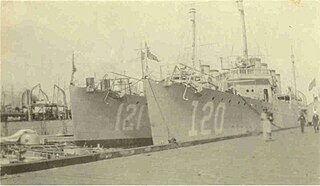
USS Mustin (DD-413) was a Sims-class destroyer of the United States Navy, the first Navy ship of that name, in honor of Captain Henry C. Mustin (1874–1923), a pioneer of naval aviation.

USS Monaghan (DD-354) was the last ship built of the Farragut-class destroyer design. She was named for Ensign John R. Monaghan. Monaghan was laid down on November 21, 1933 at the Boston Navy Yard, and launched on January 9, 1935. She was sponsored by Miss Mary F. Monaghan, niece of Ensign Monaghan, and commissioned on 19 April 1935. During the next few years Monaghan operated primarily in the North Atlantic, training US Navy personnel who served in World War II. Monaghan was present during the Pearl Harbor raid on December 7, 1941. She participated in the Battle of the Coral Sea and the Battle of Midway in 1942. Monaghan was sunk in Typhoon Cobra east of the Philippines in 1944.

The third USS Farragut (DD-348) was named for Admiral David Glasgow Farragut (1801–1870). She was the lead ship of her class of destroyers in the United States Navy.

USS Ralph Talbot (DD-390) was a Bagley-class destroyer in the United States Navy, named for USMC Second Lieutenant Ralph Talbot (1897–1918), who was awarded the Medal of Honor during World War I. Talbot served in the Pacific Theater during World War II, from the attack on Pearl Harbor through the battle of Okinawa, earning 14 battle stars for her service.

USS Montgomery (DD–121) was a Wickes-class destroyer in the United States Navy during World War I, later reclassified DM-17. She was the fifth ship named Montgomery and was named for Rear Admiral John B. Montgomery.

USS Taylor (DD/DDE-468) was a Fletcher-class destroyer of the United States Navy, named for Rear Admiral William Rogers Taylor (1811–1889). She was laid down on 28 August 1941 at Bath, Maine, by the Bath Iron Works Corp.; launched on 7 June 1942, sponsored by Mrs. H. A. Baldridge; and commissioned on 28 August 1942 at the Charlestown Navy Yard near Boston, Mass.

USS Stanly (DD-478) was a Fletcher-class destroyer in service with the United States Navy from 1942 to 1947. She was scrapped in 1972.

The first USS Dewey (DD-349) was a Farragut-class destroyer of the United States Navy, launched in 1934 and named for Admiral George Dewey. Dewey served in the Pacific through World War II. After escaping damage during the attack on Pearl Harbor, Dewey screened the aircraft carrier USS Lexington until the carrier was lost in the battle of the Coral Sea; then screened USS Saratoga through the invasion of Guadalcanal and the battle of the Eastern Solomons. Following overhaul in San Francisco, Dewey spent 1943 in Alaskan waters supporting the invasions of Attu and Kiska. Dewey spent 1944 supporting raids in the Marshalls, Carolines, and Marianas, including screening carriers during the battle of the Philippine Sea. After being damaged by Typhoon Cobra during the recapture of the Philippines, Dewey supported the invasion of Iwo Jima and spent the remainder of the war screening replenishment oilers.

The third USS Macdonough (DD-351) was a Farragut-class destroyer in the United States Navy during World War II. She was named for Thomas Macdonough.

The second USS Selfridge (DD-357) was a Porter-class destroyer in the United States Navy. She was named for Rear Admiral Thomas O. Selfridge (1804–1902) and his son, Thomas O. Selfridge, Jr. (1836–1924).

USS Patterson (DD-392), a Bagley-class destroyer, was the second ship of the United States Navy to be named for Daniel Todd Patterson, an officer of the US Navy who served in the Quasi-War with France, First Barbary War, and the War of 1812.

USS Haggard (DD-555) was a Fletcher-class destroyer of the United States Navy named for Captain Haggard of the Louisa, who fought in the Quasi-War.

USS Lardner (DD-487), a Gleaves-class destroyer, was the second United States Navy ship to be named for Rear Admiral James L. Lardner, a Naval officer during the American Civil War. Lardner received 10 battle stars for World War II service.

USS Dunlap (DD–384) was a Mahan-class destroyer in the United States Navy before and during World War II. She was named after Brigadier General Robert H. Dunlap, USMC. In some references, she is listed as a Dunlap-class destroyer. Captain was Clifton Iverson, who earned the Navy Cross during the Battle of Vella Gulf

USS Fanning (DD-385) was a Mahan-class destroyer, in the United States Navy named for Nathaniel Fanning. Her first action was during World War II, immediately following the 7 December 1941 attack on Pearl Harbor. Fanning continued to serve in the Pacific Theatre throughout the war, and was decommissioned 14 December 1945. She was one of the last Mahan-class destroyers. Fanning and USS Dunlap were built from the same basic Mahan design but slightly modified. Some sources refer to them as the Dunlap-class destroyers.

The second USS Maury (DD-401) was a Gridley-class destroyer in the United States Navy. She was named for Matthew Maury, and was one of the most decorated US Naval vessels of World War II.

USS Stack (DD-406) was a Benham-class destroyer in the United States Navy. She was named for Edward Stack.

USS Woodworth (DD-460) was a Benson-class destroyer in the United States Navy during World War II. She was named for Commander Selim E. Woodworth.
USS Skylark (AM-63) was an Auk-class minesweeper built for the United States Navy during World War II. She earned three battle stars during World War II. Skylark was mined and sunk off Okinawa in April 1945. She was struck from the Naval Vessel Register the same day.

USS Swallow (AM-65) was an Auk-class minesweeper built for the United States Navy during World War II. The ship was the second U.S. Navy ship named after the swallow. Swallow earned two battle stars for World War II service. She was sunk by a kamikaze aircraft off Okinawa on 22 April 1945. She was struck from the Naval Vessel Register on 2 June 1945.



















